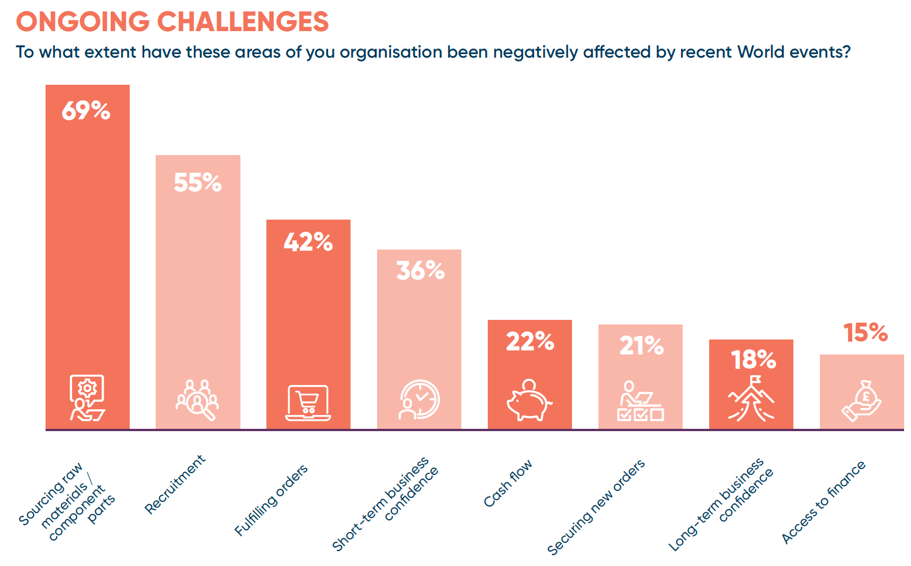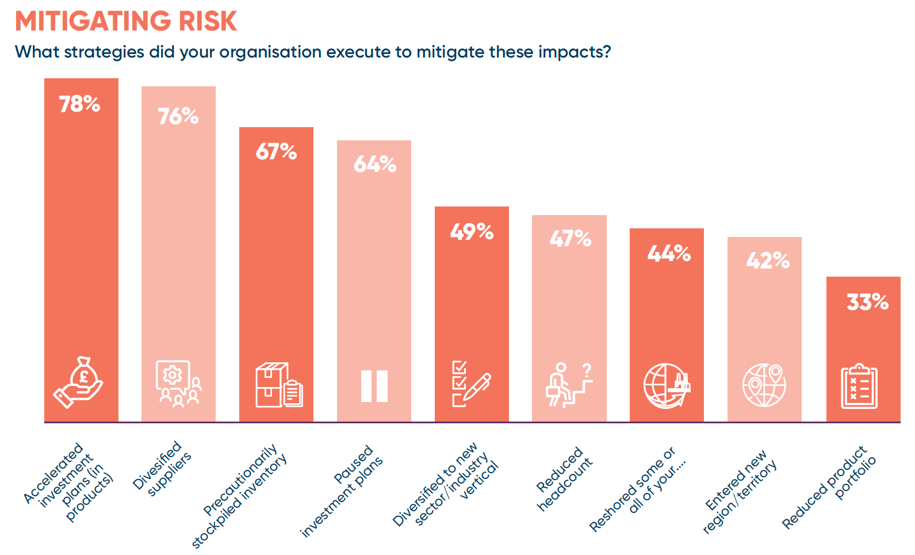How has the way your organisation manages its supply chain changed in the last 12 months?
The Supply Chain Disruption Silver Lining: Smarter Stock Management
In terms of the areas where manufacturers have been most impacted by recent world events (COVID aside) and other domestic factors, our research revealed that sourcing raw materials/components from suppliers are at the top of the list (as it was last year). And while the number of manufacturers that cited this as their biggest challenge this year (69%) represents a drop over last year (75%), the difference is still only small.
The bottom line is most manufacturing organisations continue to be significantly impacted when it comes to sourcing raw materials and components. This is despite us now living in the so-called “new normal” with most of the pandemic’s effects, in theory, behind us.
The silver lining through all of this is that it has forced many manufacturing organisations to adapt and take advantage of technology to forecast better. First, why are so many manufacturers still struggling to source raw materials and components? Several reasons were uncovered during our follow-up discussions. We discovered that the COVID hangover is still lingering, particularly when it comes to sourcing raw materials from the Far East.

While we’ve seen shipping resume, it is nowhere near the level it was before
“During COVID, most of the factories in Taiwan where we purchase our semiconductor chips shut down. And while a lot has since reopened, their reduced capacity and a huge backlog of orders mean we simply cannot get chips on time”, a Board Member at a global automotive manufacturer told us.
Exacerbating the semiconductor supply situation is significantly slower shipping. “While we’ve seen shipping resume, it is nowhere near at the level it was before. It seems that while ships – particularly those from the Far East – are sailing, they’ve slowed down considerably”, the same executive explained. One explanation for this could be shipping companies preparing for a new requirement from the International Maritime Organisation (IMO), which will come into force next year. Under the new rules, all ships will be required to calculate their carbon emissions and show that they are progressively coming down.
The quickest fix is to sail slower, with a 10% drop in cruising speeds potentially leading to a 30% reduction in fuel usage. Meanwhile, other manufacturers are still facing Brexit-related supply chain challenges. One chemical manufacturer we spoke with outlined how leaving the European Union (EU) has left them dealing with pallet problems.

We’ve enhanced our business intelligence tools with digital technology to improve visibility and decision making
Under the formal trade agreement signed between the EU and the UK, every wooden pallet entering Europe from the UK must be treated to meet ISPM15 standards to prevent the spread of plant diseases and pests.
As a result, pallet prices increased and supply dwindled, leaving said manufacturer struggling to secure stock. “Imagine what it does to your agility when you can’t get hold of pallets anymore”, he said. In the face of significant supply chain issues and stock shortages, it’s no wonder that our research revealed that 76% of manufacturers have diversified their suppliers and 67% have precautionarily stockpiled inventory. However, there is a plus side to these supply issues though, as we discovered. Forced to adapt, many manufacturers have investigated how they can forecast better. The Chief of Digital Manufacturing at a global aerospace and defence firm said: “We’ve enhanced our business intelligence tools with digital technology to improve visibility and decision making”.
Finally, for one manufacturer of high-performance EMC/EMP filters and capacitor products, an increase in stock holding of critical components and those identified as having long lead times or risk of shortages has put increased pressure upon cash flow. However, as a senior executive at the company told us: “Accurate inventory management and good forward forecasting using historical usage data has ensured that the correct amount of stock is procured”.
63%
Increased Risk awareness/management
49%
Introduced multisource supply for key raw materials/component parts
44%
Changed relationships with suppliers to be more open and collaborative


